I would love to get some feedback on a moon panel that I put together lately:
https://www.astrobin.com/neffua/B/
Acquisition details
- 36 tiles of an 81% gaining moon
- clear cool night end of may with little to zero wind and good visibility and thus goo seeing
- taken on an 8" Newtonian with 1000mm focal length extended to 3000mm with a 3x Barlow
- on my new ZWO AM5 mount that runs very nicely and stable (<0,5" when guiding stars) and was polar aligned <50"
- taken with an ASI 2600 mc OSC using AsiAir
- 2minutes per tile video (=2000 frames) at 5ms exposure/frame (so overall around 70.000 frames of which I stacked 25%
Processing details
- stacked in Autostackert with 3x drizzle (hoping to benefit form air distortion "dithering")
- wavelet sharpened in Registax with linked gaussian layers
- stitched with ICE
- polished with Photoshop
So overall I am quite happy, but not fully, as:
- some panel show slight deviance from neighbour despite identical processing
- resolution is not superior compared to more simple panoramas without a barlow
- does bring the extra load of drizzling enough benefit
- the details are not as stunningly sharp as I admire on some of your great works
- it was just too much work for the outcome - but a great journey :-)
Any idea of where I could imrove acquistion or processing is greatly appreciated.
Also if there is a trick to batch process Registax only for wavelet sharpening (it seems it only allows batch for full process - and tends to crash)
Arny
|
You cannot like this item. Reason: "ANONYMOUS".
You cannot remove your like from this item.
Editing a post is only allowed within 24 hours after creating it.
You cannot Like this post because the topic is closed.
|
Try not to drizzle as it is a waste of time if you ask me. Besides, the full scale image looks quite blocky.
|
You cannot like this item. Reason: "ANONYMOUS".
You cannot remove your like from this item.
Editing a post is only allowed within 24 hours after creating it.
You cannot Like this post because the topic is closed.
Your original revision is much cleaner. Whatever you did with the "fine tuning in iPhotos" crushed your image. Lots of compression artifacts. Over sharpened. Too contrasty. I agree with Andrea that drizzling isn't worth the time/effort.
36 panel mosaic is one heck of a project. Way more than I've attempted  . .
|
You cannot like this item. Reason: "ANONYMOUS".
You cannot remove your like from this item.
Editing a post is only allowed within 24 hours after creating it.
You cannot Like this post because the topic is closed.
Hi Arny,
Try the Adobe Lightroom Stitcher if you can. Photoshop may have the same, I don't know.
This is working in a different league.
I read you were using a ASI2600, why would you need that many frames? You just could have used 4.
See my recently done 6 panel Mosaic with a 4" refractor.
Moon Mosaic
My steps were similar, in stead of using Lightroom for stitching an polishing.
Do the individual frames looked like compared to the Mosaik?
Maybe you just had sub optimal seeing or tube currents.
BR,
Stephan
|
You cannot like this item. Reason: "ANONYMOUS".
You cannot remove your like from this item.
Editing a post is only allowed within 24 hours after creating it.
You cannot Like this post because the topic is closed.
Stephan Linhart:
Hi Arny,
Try the Adobe Lightroom Stitcher if you can. Photoshop may have the same, I don't know.
This is working in a different league.
I read you were using a ASI2600, why would you need that many frames? You just could have used 4.
See my recently done 6 panel Mosaic with a 4" refractor.
Moon Mosaic
My steps were similar, in stead of using Lightroom for stitching an polishing.
Do the individual frames looked like compared to the Mosaik?
Maybe you just had sub optimal seeing or tube currents.
BR,
Stephan
Hi, regarding Lightroom do you mean Photo Merge > Panorama or LR has another function for such tasks of which I am not aware of?
Anyway, I find LR's Panorama tool far easier than trying to do the same with Photoshop. I had some great success using LR's Panorama on stretched tiles from widefield deep sky projects.
|
You cannot like this item. Reason: "ANONYMOUS".
You cannot remove your like from this item.
Editing a post is only allowed within 24 hours after creating it.
You cannot Like this post because the topic is closed.
Hi Diva,
you are correct. I mean the Panorama Tool.
Its working like a charm with no visible artefacts. At least on the Moon.
Another mosaic with a different scope I took last year.
Moon Mosaic
Arny, if you are really into imaging the moon I can also strongly recommend a camera with the 178 chip.
Since are also using a Newtonian, have a fan running to establish a steady airflow through the tube. Just a fan blowing from behind on the mirror is not enough. The fan needs to be mounted in such a way that the rear of the scope is closed off and there is only an opening for the fan(s).
Otherwise the air will not flow through the tube but only swirl around the fan.
This will help cooling the mirror but not eliminating the dreaded tube currents that are usually far worse than actual seeing.
Cheers,
Stephan
|
You cannot like this item. Reason: "ANONYMOUS".
You cannot remove your like from this item.
Editing a post is only allowed within 24 hours after creating it.
You cannot Like this post because the topic is closed.
andrea tasselli:
Try not to drizzle as it is a waste of time if you ask me. Besides, the full scale image looks quite blocky.
thanks, Andrea
where do you think comes the blockiness from or what exactly you mean.
is it too mich contrast in photoshop or maybe just an JPG export artefact?
|
You cannot like this item. Reason: "ANONYMOUS".
You cannot remove your like from this item.
Editing a post is only allowed within 24 hours after creating it.
You cannot Like this post because the topic is closed.
Stephan Linhart:
Hi Arny,
Try the Adobe Lightroom Stitcher if you can. Photoshop may have the same, I don't know.
This is working in a different league.
I read you were using a ASI2600, why would you need that many frames? You just could have used 4.
See my recently done 6 panel Mosaic with a 4" refractor.
Moon Mosaic
My steps were similar, in stead of using Lightroom for stitching an polishing.
Do the individual frames looked like compared to the Mosaik?
Maybe you just had sub optimal seeing or tube currents.
BR,
Stephan
indeed a very crisp and clean pano you put up yourself!
on the blockiness: I reckon I must have done some final final touching on the iphone when I morrored the imaged, which might have introduced some of the artefacts.
I went into soo many panels as I was trying to get more detail by using the 3x Barlow, which then forced me into soo many panels despite the asi2600 Apsc sensor.
But looking at your Apo taken images I wonder whether a newtonian is maybe less ideal for collimation sensitivy. I took it for greater aperture and thus detail, but your Apo proves me wrong.
|
You cannot like this item. Reason: "ANONYMOUS".
You cannot remove your like from this item.
Editing a post is only allowed within 24 hours after creating it.
You cannot Like this post because the topic is closed.
Stephan Linhart:
Hi Diva,
you are correct. I mean the Panorama Tool.
Its working like a charm with no visible artefacts. At least on the Moon.
Another mosaic with a different scope I took last year.
Moon Mosaic
Arny, if you are really into imaging the moon I can also strongly recommend a camera with the 178 chip.
Since are also using a Newtonian, have a fan running to establish a steady airflow through the tube. Just a fan blowing from behind on the mirror is not enough. The fan needs to be mounted in such a way that the rear of the scope is closed off and there is only an opening for the fan(s).
Otherwise the air will not flow through the tube but only swirl around the fan.
This will help cooling the mirror but not eliminating the dreaded tube currents that are usually far worse than actual seeing.
Cheers,
Stephan
hi Stephan,
you are a source of wisdom - thank you!
what feature of the 178 chip makes it prone for moon fotography?
I will try to figure out a tube current fan solution. Is this DIY tinkering or are there good solutions available?
Arny
|
You cannot like this item. Reason: "ANONYMOUS".
You cannot remove your like from this item.
Editing a post is only allowed within 24 hours after creating it.
You cannot Like this post because the topic is closed.
Arny:
thanks, Andrea
where do you think comes the blockiness from or what exactly you mean.
is it too mich contrast in photoshop or maybe just an JPG export artefact?
The blockiness is likely due to your use of drizzle or maybe you doubled the size again?
At 1000mm of focal length you have 0.78"/px of image scale using an IMX571 sensor whic should give you a nice resolution. With 2x good barlow you'd need two panes and you'd end up with an image scale of 0.39"/px (which is plenty to bring many features to show up) to cover the full moon but you might get away with just one if the phase isn't full.
At any rate at whatever the image scale is seeing is the driving factor for high resolution APs. I have used newts for over 30 years and very rarely observed tube currents other than for the first hour or so in hotter days. So much so that I removed all those fan gizmos as pointless.
Remind also that you'd still need a coma corrector shooting with a APS-C sensor or better still use a coma correcting barlow (APM's is a good one).
|
You cannot like this item. Reason: "ANONYMOUS".
You cannot remove your like from this item.
Editing a post is only allowed within 24 hours after creating it.
You cannot Like this post because the topic is closed.
Hey guys,
thanks a lot for your inspiration and advice!
I went back to the beginning and reprocessed from scratch in rder to dodge the issues you called out:
- Autostackert with no drizzle and only using top10% of frames
(as requested please find one original panel for in the revisions)
- did all stitching, camera aw polishing and high pass filter in Photoshop
see yourself if the result is better: https://www.astrobin.com/neffua/B/
(uploaded it as png as not to introduce jpg artefacts)
What I found out:
- Photoshop with Hipass and Camera Raw sharpening gets close to Registax - only it is not limited by 6200 pixel image size
- Microsoft ICE did introduce some bad artefacts and color mismatches so got kicked out
- Lightroom to my surprise could not stitch the frames - whenever it runs into a bad frame it skips it - Photoshop is bit mor forgiving and transparent here
Arny
|
You cannot like this item. Reason: "ANONYMOUS".
You cannot remove your like from this item.
Editing a post is only allowed within 24 hours after creating it.
You cannot Like this post because the topic is closed.
|
Your black point is too "black". You should really set to some dark shade of gray. It is hugely pixellated at full scale though.
|
You cannot like this item. Reason: "ANONYMOUS".
You cannot remove your like from this item.
Editing a post is only allowed within 24 hours after creating it.
You cannot Like this post because the topic is closed.
I made quite the opposite observation with my selfmade Newtonian and the Mewlon where I live.
True is the tube currents are reduced a lot without a fan over time, but it takes roughly two or three hours easily. But I carry out my scope each time and 10in Mirrors are also more prone due to bigger glass mass.
I see it live when I turn on the fans, after a minute or so the seeing becomes much better.
Arny,
I made it myself:
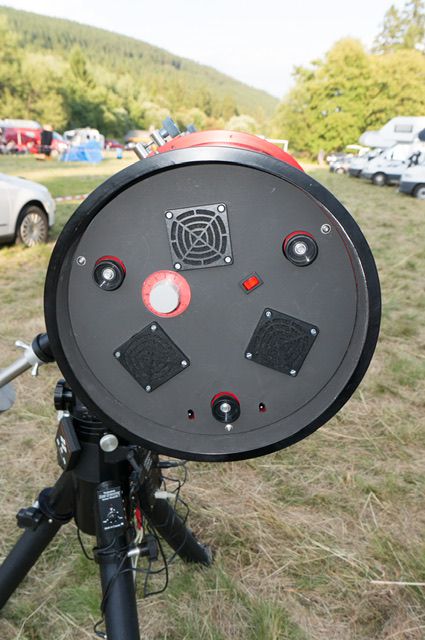
But you can also buy:
https://lacerta-optics.com/LaCool235_Kuhl-Ventilator-in-8-zoll-Saugkappe-eingebaut-fur
But I agree wirh Andrea, Newtonians are great with Lunar and Planetary Imaging. I use my Newton mainly for planets. Reason I was doing the Moon with my Refractors was pirely because I was traveling or was just a side project while I was doing other stuff with the Newton or Mewlon.
|
You cannot like this item. Reason: "ANONYMOUS".
You cannot remove your like from this item.
Editing a post is only allowed within 24 hours after creating it.
You cannot Like this post because the topic is closed.
|
Your revision D is _MUCH_ better.
|
You cannot like this item. Reason: "ANONYMOUS".
You cannot remove your like from this item.
Editing a post is only allowed within 24 hours after creating it.
You cannot Like this post because the topic is closed.
|
I have 6/10/12 inch newtonians, all with open back. Once, i clocked the time it takes to settle down after blasting the 10" primary with an hair dryer (3 kW) at max settings for a good 15 min. It took less than half an hour. In all my observing life I might have witnessed heat plumes an handful of time and mostly with poorly designed newtonians.
|
You cannot like this item. Reason: "ANONYMOUS".
You cannot remove your like from this item.
Editing a post is only allowed within 24 hours after creating it.
You cannot Like this post because the topic is closed.
Andrea,
If I would do that my neighbours and wife would kill me
Would you consider my newton of bad design thermal wise? Appreciate your advice.
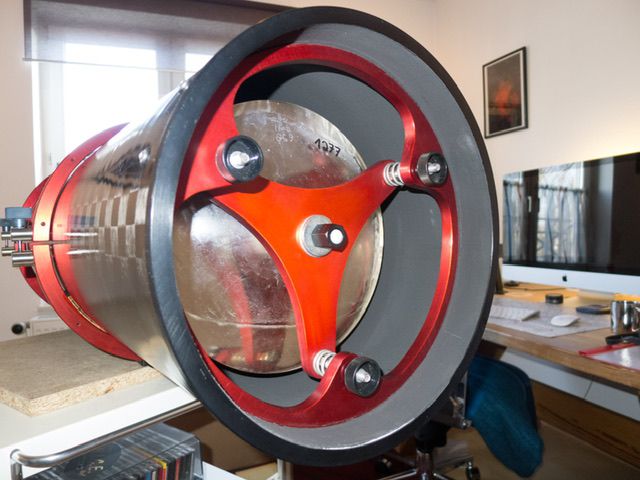 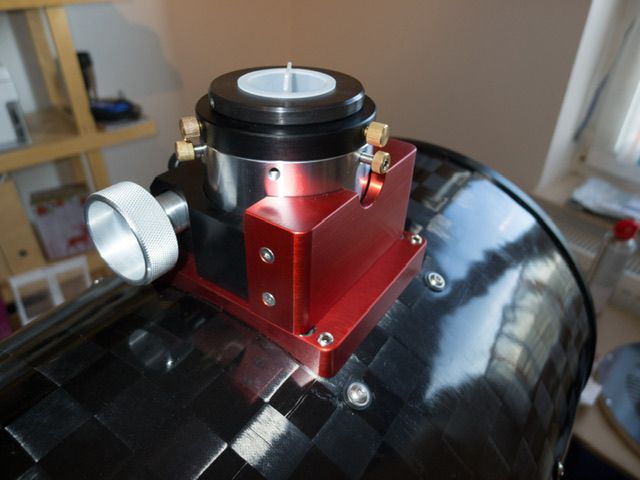 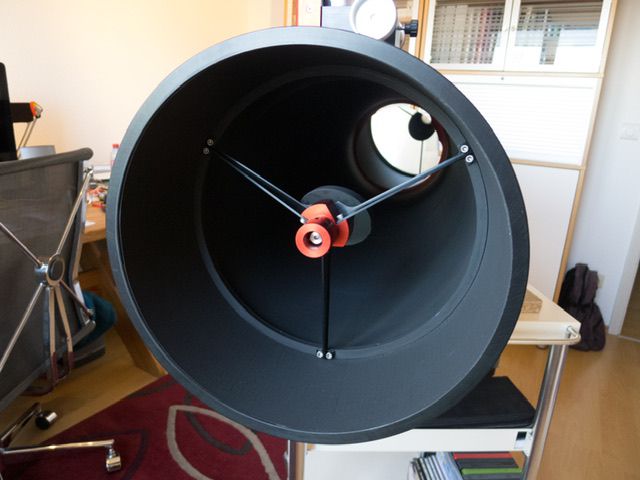
Cheers!
|
You cannot like this item. Reason: "ANONYMOUS".
You cannot remove your like from this item.
Editing a post is only allowed within 24 hours after creating it.
You cannot Like this post because the topic is closed.
Stephan Linhart:
Andrea,
If I would do that my neighbours and wife would kill me
Would you consider my newton of bad design thermal wise? Appreciate your advice.
  
Cheers!
You have a lovely newt over there, my hat off to you sir.
I have, however, few points to make:
1. For all the stiffness to mass ratio of carbon fiber I know the heat conduction isn't one of its strong points. I'm still on the fence on that and on balance I'd rather have rolled steel tube to that, if I could chose. This gives much better heat conduction out, especially if the external is painted white (such as most of mine). The flip side is that chances of dew forming on the primary are higher.
2. It might be that the primary is too far in for effective heat convection outside of the tube. My best perfoming newt (the 10") is as close as possible to the end of the tube. Obviously, if you employ active cooling then the point is moot.
3. Any form of baffle, intentional or not, should be frowned upon.
4. Primary material should really be either Pyrex, Zerodur or quartz.
|
You cannot like this item. Reason: "ANONYMOUS".
You cannot remove your like from this item.
Editing a post is only allowed within 24 hours after creating it.
You cannot Like this post because the topic is closed.
Hi Andrea, thanks for your insight, mich appreciated.
Most, no all, of the points you mentioned cannot be changed. The baffles are connected directly to the focuser and the main mirror is farther in due to its conical shape.
So i will let the fans turn at lowest speed once cooled down.
But its true that the mirrors never had dew problems the past 15 years.
Cheers,
Stephan
|
You cannot like this item. Reason: "ANONYMOUS".
You cannot remove your like from this item.
Editing a post is only allowed within 24 hours after creating it.
You cannot Like this post because the topic is closed.
Stephan Linhart:
Andrea,
If I would do that my neighbours and wife would kill me
Would you consider my newton of bad design thermal wise? Appreciate your advice.
  
Cheers!
Oh wow, you went serious about buildng your own Newtonian. Very impressive!
Is all mechanics and tube self made on a CNC or did you allow some stuff off the shelf?
Arny
|
You cannot like this item. Reason: "ANONYMOUS".
You cannot remove your like from this item.
Editing a post is only allowed within 24 hours after creating it.
You cannot Like this post because the topic is closed.
Hi Arny,
thanks! All the mechanical parts are selfmade, except the Tube itself. This is of special design.
The main mirror was made by Bob Royce, but the Coma Corrector optics were selfmade.
I wanted a larger back focus and larger diameter than was commercially available at the point of making.
Anodizing the parts was a huge mess.
There is an inner and outer Carbon fibre tube with an Aramid honey comb layer laminated in between.
This way the tube is extremely stiff but still very light and robust.
Overkill? Yes! But I liked it.
I learned a lot while making this and took me roughly 2.5years as I not always had access to the machines needed.
You can try adding a fan runnung at low speed. There is no big investment needed when doing it yourself. A fan, wires, wood or similar sheet marterial. At least it will help reducing the cool down time.
Only occasionally I do planetary imaging, so no expert. But still things like this are possible:
Jupiter
Stephan
|
You cannot like this item. Reason: "ANONYMOUS".
You cannot remove your like from this item.
Editing a post is only allowed within 24 hours after creating it.
You cannot Like this post because the topic is closed.
Recalling this discussion I acrualy measured the time on one of my newts last night, after being exposed to the Sun the whole day, with peak temperatures (in the shade) at around 30 degC. The picture below show the HFR of the 6" since the start of the session, shortly after the cover removed, slewed to target and plate-solved it, so around 5min.
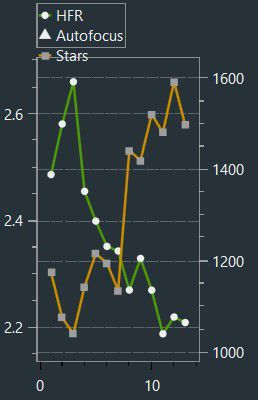
Each integration is worth 3 min, so for the first 10 min the heat plume steadly makes the PSF worse after which the heat plume start to abate and quite drammatically too so that at the 11th integration the local seeing has stabilized and the effects of the heat plume completely dissipated. The 12" was running at the same time (but no NINA with that one) but the behaviour pretty much followed the same pattern and if anything it was faster in cooling down, possibly because was pointing at higher intial altitude.
|
You cannot like this item. Reason: "ANONYMOUS".
You cannot remove your like from this item.
Editing a post is only allowed within 24 hours after creating it.
You cannot Like this post because the topic is closed.
to create to post a reply.








